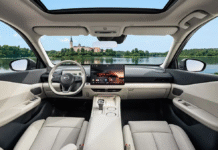Humanoid Robots Revolutionizing Film Production: Boston Dynamics’ Atlas in Action
Introduction to the Future of Filmmaking
In an era where technology is evolving at a breakneck pace, humanoid robots have transcended their traditional roles. No longer limited to tasks such as jumping, running, or assisting in warehouses, these robots are now stepping into the spotlight of film production. Leading this charge is the Atlas humanoid robot developed by Boston Dynamics, a machine that is assisting in unique ways during film shoots, significantly transforming the cinematography landscape.
The Evolution of Technology in Cinema
With advancements in robotics and camera technology, film production is entering a new age. Atlas is not just a mechanical arm holding a camera; it’s a sophisticated system that enhances creative potential while keeping human operators safe in potentially hazardous environments. The collaboration between WPP, a UK-based creative transformation agency, Boston Dynamics, and Canon illustrates how technology is breaking new ground in content creation.
Atlas: Bridging Innovation and Creativity
The joint venture of WPP and Boston Dynamics aims to explore unprecedented creative possibilities through the use of Atlas. Their disparate talents converge to push boundaries, showing that now, more than ever, technology serves to augment human creativity rather than replace it. Vatche Arabian, Senior Marketing Manager at Boston Dynamics, remarked, “When we saw that WPP was using the Spot robot, it inspired us to offer Atlas in content production.” This philosophy underlines the prevailing notion: technology can elevate artistry, much like drones that have revolutionized aerial storytelling.
Creating a functional robotic platform capable of operating in the film industry is no easy feat. As Perry Nightingale, SVP for Creative AI at WPP, explains, “For general-purpose robotic platforms like Atlas, a large amount of training data is crucial.” However, acquiring relevant data can prove challenging. In many cases, it doesn’t exist, necessitating synthetic generation. To train Atlas effectively, WPP utilized Nvidia Cosmos. This powerful tool provides world foundation models that help produce AI-driven imagery, equipping Atlas with the knowledge required for various film scenarios.
Simulations and Realities: Training in the Virtual World
WPP’s creative technologist, Rocio Rey, emphasizes the advantage of simulations. “We can take simulations of complex environments from Nvidia Universe, such as film sets, and generate photorealistic, synthetic training data in Nvidia Cosmos.” This innovative use of virtual reality offers Atlas an extensive preparatory period, enabling it to excel at precise and complex movement.
Mastering the Art of Cinematic Angles
What truly sets Atlas apart in film production is its ability to shoot from awkward positions and handle extensive payloads with ease. With the capability to lift objects weighing up to 20 kilograms, Atlas can maintain perfect balance while executing intricate camera angles, a feat often challenging for human cinematographers. This precision is essential for capturing repeatable shots essential in filmmaking.
Exploring The Inaccessible
One of the unique strengths of Atlas lies in its ability to venture into locales that would be impossible or dangerous for human crews to access—think active volcanoes or teeny, tight spaces on set. Enah Lee, a creative technologist at WPP, recalls the moment Atlas first operated behind a camera: "It was amazing to see Atlas working for the first time; it was a dream come true moment." Such breakthroughs open doors to new storytelling opportunities.
A Revolutionary Robot: Dynamic Movement
Boston Dynamics asserts that Atlas is the world’s most dynamic humanoid robot, engineered for real-world applications. Its advanced control systems and state-of-the-art hardware enable it to perform a wide array of athletic and agile tasks. Not just a simple robotic arm, Atlas is designed to emulate the fluid motion and precision of a human operator, ultimately enriching the filmmaking process.
Autonomous Functionality Meets Human Creativity
This innovative robot has shown it can autonomously move components on a film set. Recently, Atlas effortlessly transported engine covers between supplier containers and a mobile sequencing dolly, demonstrating its capability to follow input lists while executing complex tasks. Boston Dynamics highlights that Atlas utilizes machine learning (ML) vision models to detect and localize environmental fixtures and individual bins. This technology significantly enhances the efficiency of production workflows.
Collaborative Efforts: A Testament to Innovation
The transformation of the film industry thanks to robotic technology fosters collaboration, not merely between human artists and machines, but across industries ranging from AI to robotics. Each player brings a unique skill set, and it is this collaborative synergy that allows for innovation, thus elevating storytelling as we know it.
Towards an Integrated Future
As Atlas continues to be integrated into various aspects of film production, one cannot help but wonder how far-reaching its impacts could be. With new advancements occurring regularly, Atlas is not just a tool for cinematographic enhancement but a precursor for future filmmakers. How will this technology shape creative narratives and industry standards in years to come?
Adapting to New Challenges
The future of film production is inherently linked to advancements in robotics and artificial intelligence. The challenges of acquiring the necessary training data for robots like Atlas are being addressed through ongoing technological innovations. This proactive approach means that as we develop better data generation techniques, our capacity for creative visual storytelling will deepen.
Ethical Considerations and Future Potential
While the possibilities of integrating robots into film production are exhilarating, it prompts significant ethical discussions about the role of technology in creative industries. Will filmmakers and audiences embrace robotic contributions? As long as humans remain at the helm—guiding the story and establishing the emotional core— there could be room for harmonious coexistence.
Atlas as a Game Changer in Storytelling
The cinematic world is just beginning to realize the profound implications of incorporating humanoid robots like Atlas. The combination of precision engineering and creative insight can potentially change how stories are told and experienced. By pushing the envelope of what is possible, Atlas could redefine cinematography for years to come.
Looking Ahead: The Future of Filmmaking
Through collaborations like that of WPP, Boston Dynamics, and Canon, and the growing acceptance of robotics in the creative realm, we are inching closer to a revolutionary shift in film production. As tools and technologies evolve, we will likely see an even greater amalgamation of creative human thought and robotic precision.
Conclusion: A New Era Awaits
As we continue to explore the capabilities of humanoid robots like Atlas in the film industry, it’s evident that this technology is not a mere spectacle but a transformative force. By augmenting human creativity and expanding what filmmakers can achieve, Atlas embodies a future of filmmaking that blends artistry with groundbreaking technology. As we look ahead, we can only imagine the stories yet to be told through the lens of robotic innovation.







